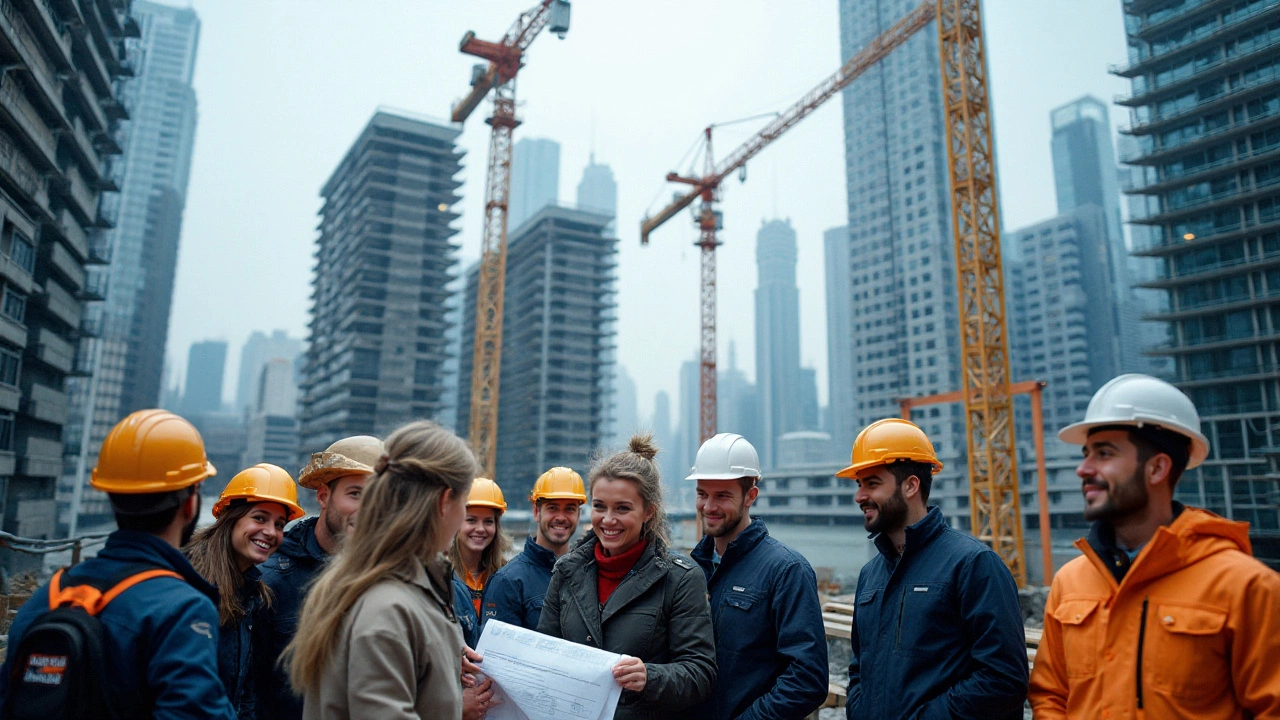In the realm of commercial construction, understanding the nuances of different building classifications is crucial. One of these classifications is Type C Construction, a term that often comes up in discussions about building safety and compliance. This construction type plays a vital role in determining the materials and methods suitable for various commercial projects.
Type C Construction typically involves structures with lower fire-resistance requirements, making them a budget-friendly option for projects where extreme durability isn't necessary. This doesn't mean they're unsafe; instead, they’re well-suited for scenarios where stringent fire-resistance measures are not as critical.
Knowing the ins and outs of Type C Construction can significantly aid in making informed decisions when it comes to planning and executing commercial architectural endeavors. This article dives into what defines Type C Construction, its place within building regulations, and how it meets the needs of modern commercial structures.
- Definition and Characteristics
- Regulations and Standards
- Applications in Commercial Projects
- Advantages and Considerations
Definition and Characteristics
When delving into the world of construction, especially in the commercial sector, understanding the categorization of building types is essential. Type C Construction stands out due to its distinctive characteristics that balance functionality with cost-effectiveness. This classification typically signifies structures designed with lower fire-resistance requirements compared to their Type A and Type B counterparts. Materials used in Type C are often less robust in terms of fire resistance, opting instead for an efficient blend of affordability and safety. Builders often employ non-combustible internal fabrics for walls, floors, and roofs, yet the focus shifts from purely safety towards an equilibrium between safety, economy, and design flexibility.
This type of construction is particularly relevant for commercial buildings where there's no necessity for high-rise structural integrity or extreme durability. Think of establishments like small retail stores or mid-size office spaces that benefit from the lower costs associated with these standards. Notably, buildings under Type C Construction do not require the same level of fire suppression systems as more resistant structures. Instead, the design process might incorporate practical, efficient solutions into the infrastructure, which reduces both upfront and maintenance costs, making it attractive financially. However, it's essential to note that while these buildings might have less stringent requirements, they still adhere to safety standards as prescribed by local regulations, ensuring a safe environment for occupants.
In exploring this category, one might wonder about industry perspectives on its viability. As Eric Londquist, a renowned industry consultant, once aptly mentioned:
"Type C Construction bridges the gap between minimalism and necessity, offering flexibility for developers while maintaining fundamental safety protocols."Such insights paint a broad picture of its acceptance and adaptability in varying project requirements. Developers should be aware that while this option is cost-effective, it must be carefully assessed against the building's intended use to align with safety and compliance needs. The versatility of Type C allows architects to often experiment with innovative design while keeping expenses in check.
The evolving regulations also play a pivotal role in the characteristics of commercial construction. Building codes tend to specify dimensions, materials, and techniques, and staying updated with these is crucial for any project. In some cities, Type C Criteria are redefined based on recent fire risk assessments, pushing architects to reinvent how these simpler building types can meet modern demands without inflating costs unnecessarily. These changes can be seen as a testament to the dynamic nature of construction realities, emphasizing risk management. To summarize the specifics:
- Materials are generally non-combustible yet less fire-resistant
- Compliance with local safety regulations remains a priority
- Suitability for non-high-rise, medium-occupancy projects
- Innovative design possibilities due to lesser restrictions
- Cost-effectiveness is a primary advantage for developers
These characteristics make Type C Construction a judicious choice for many urban landscapes where space, budget, and utility converge. With a meticulous approach to planning and execution, it can lead to practical and sustainable results that meet the nuanced needs of the commercial sector.

Regulations and Standards
When diving into the realm of Type C Construction, understanding the regulations and standards is paramount. As with any construction classification, compliance with local and national building codes is essential to ensure safety and efficiency. Type C buildings are typically required to meet specific fire-resistance standards, albeit less stringent than Types A and B. These structures are designed to offer reasonable fire safety without the additional structural precautions found in more robust classifications. The fire ratings, defined in building codes, dictate how long a building can withstand a fire before succumbing.
The International Building Code (IBC) often serves as the primary guideline in the United States, outlining the requirements for fire safety, structural integrity, and material use. According to the IBC, a Type C building may have fewer fire-resistance-rated elements, such as walls and floors, compared to its Type A and B counterparts. These elements often determine the fire separations required between different units or floors, directly impacting the design process and materials used.
One key advantage of adhering to these regulations is the cost-effectiveness it provides. By focusing on aspects critical to the building's function while allowing some leniency in others, projects can be executed more economically. Notably, Type C Construction often involves using lower-cost materials since they don't need extensive fireproofing treatments. This balance of safety standards and cost is why many developers choose Type C for warehouses, small-scale commercial properties, and other similar projects.
"Understanding the specific requirements of building classifications is essential for effective project planning and execution," notes a report from the National Institute of Building Sciences.
Inspectors play a crucial role in ensuring that Type C Constructions remain compliant with the specified standards. Regular inspections during the building phase ensure that materials and methods adhere to approved regulations. A failure in compliance not only jeopardizes safety but can also lead to legal and financial repercussions. Therefore, keeping up to date with any changes or updates to the building codes is beneficial to maintain best practices in construction projects.
Interestingly, a trend observed in recent years is the push for sustainability within Type C projects. While not always mandated, incorporating eco-friendly materials and designs can offer bonuses in terms of tax incentives and reduced energy costs. As cities aim to improve their environmental footprints, applying these innovative solutions within Type C regulations can be beneficial. This adaptation allows builders to create functional, cost-effective spaces that also contribute to broader ecological goals.

Applications in Commercial Projects
Type C Construction stands out in the landscape of commercial construction for its unique balance between affordability and functional design. Developers find it especially appealing when constructing buildings that require a less intensive approach to fire safety without compromising on essential security protocols. Particularly, this classification is often used in low-rise buildings, such as shopping centers and small office complexes, where the risk of fire spread is less compared to high-rise structures. These settings capitalize on the flexibility of materials that Type C Construction allows, such as wood and lightweight steel, which offer both cost efficiency and structural reliability. As commercial enterprises constantly seek ways to optimize investments, the option to design with Type C standards offers a practical pathway to achieving both economic and operational objectives.
The standards governing Type C Construction also fit well with buildings that serve multifunctional purposes, like retail-and-warehouse complexes. These facilities often do not require the extensive use of fireproof materials mandated by higher construction types. Instead, they rely on integrated fire protection systems supported by strategic building design to ensure safety. This construction type allows designers to creatively play with space, ensuring that both aesthetic and functional space needs are met without exorbitant costs. For instance, the use of shared spaces within malls or smaller scale commercial hubs can be efficiently managed with Type C protocols, providing an inviting and open atmosphere to shoppers and tenants alike.
Interestingly, as the trend towards sustainable and green building practices and materials continues to grow, Type C Construction is uniquely positioned to incorporate these elements into its design methodologies. Developers are increasingly exploring the use of eco-friendly materials within Type C frameworks that align with sustainability targets while meeting both safety and performance requirements. The adaptability of this construction type allows for innovations such as green roofs or solar panel installations, providing an additional layer of environmental responsibility. Additionally, the flexibility inherent in the Type C approach encourages the use of renewable materials, reducing the overall environmental footprint.
"Type C Construction offers a compelling cost-benefit equation, allowing for creative engagement with space and materials while maintaining safety standards, which is essential in today's competitive market," notes Dr. Harold Thompson, a renowned figure in architectural engineering.Such endorsements highlight the strategic advantages Type C standards bring to modern building practices. As cities evolve and commercial areas expand, the role of cost-effective construction solutions becomes ever more critical. With its firm foothold in practicality, Type C Construction remains an attractive choice for many builders aiming to deliver functional commercial spaces without overshooting budgets.

Advantages and Considerations
When considering Type C Construction, there are numerous advantages that can appeal to those embarking upon commercial construction projects. One of the primary benefits lies in its cost-effectiveness. Since these structures generally have lower fire-resistance requirements, the materials and methods used are often less complex, which can lead to significant savings in both time and finances. In the competitive world of commercial development, where every dollar counts, this can provide a substantial advantage.
The efficiency of building with non-combustible materials also makes Type C Construction an attractive choice. These materials are easier to work with and allow for faster project timelines. This can be particularly appealing in urban environments where space constraints and deadlines are tight. In many city projects, there’s a constant demand for rapid development to meet expanding business needs. By opting for Type C Construction, developers can address these demands without compromising on the essential attributes of safety and functionality.
However, it’s crucial not to overlook certain considerations that come with this type of construction. A key aspect to consider is the regulatory environment which varies from region to region. Understanding local building codes and ensuring compliance can sometimes be complex. The International Building Code, which regulates standards across many areas, outlines specific fire resistance ratings that must be adhered to, even in less stringent classifications like Type C. As noted by the American Institute of Architects, "Every project comes with its unique set of challenges, and navigating building codes is one of the most universal."
When planning for commercial construction, it’s also important to weigh the longevity and life-cycle costs associated with the chosen materials. Although the initial outlay for Type C Construction might be lower, developers should consider the maintenance and potential updating costs in future years. A building's life span and adaptability can significantly affect its value, especially if market demands shift or technological advancements prompt a reconsideration of current facilities.
Moreover, another critical consideration is the intended usage of the building. While Type C might be sufficient for simple commercial settings, more complex facilities that demand greater structural integrity and fire safety might necessitate a different approach. It's about aligning the construction type with the specific demands and expectations of the project. Thus, while Type C offers appealing benefits, a thorough analysis of its suitability for the desired application remains an indispensable part of the decision-making process.
